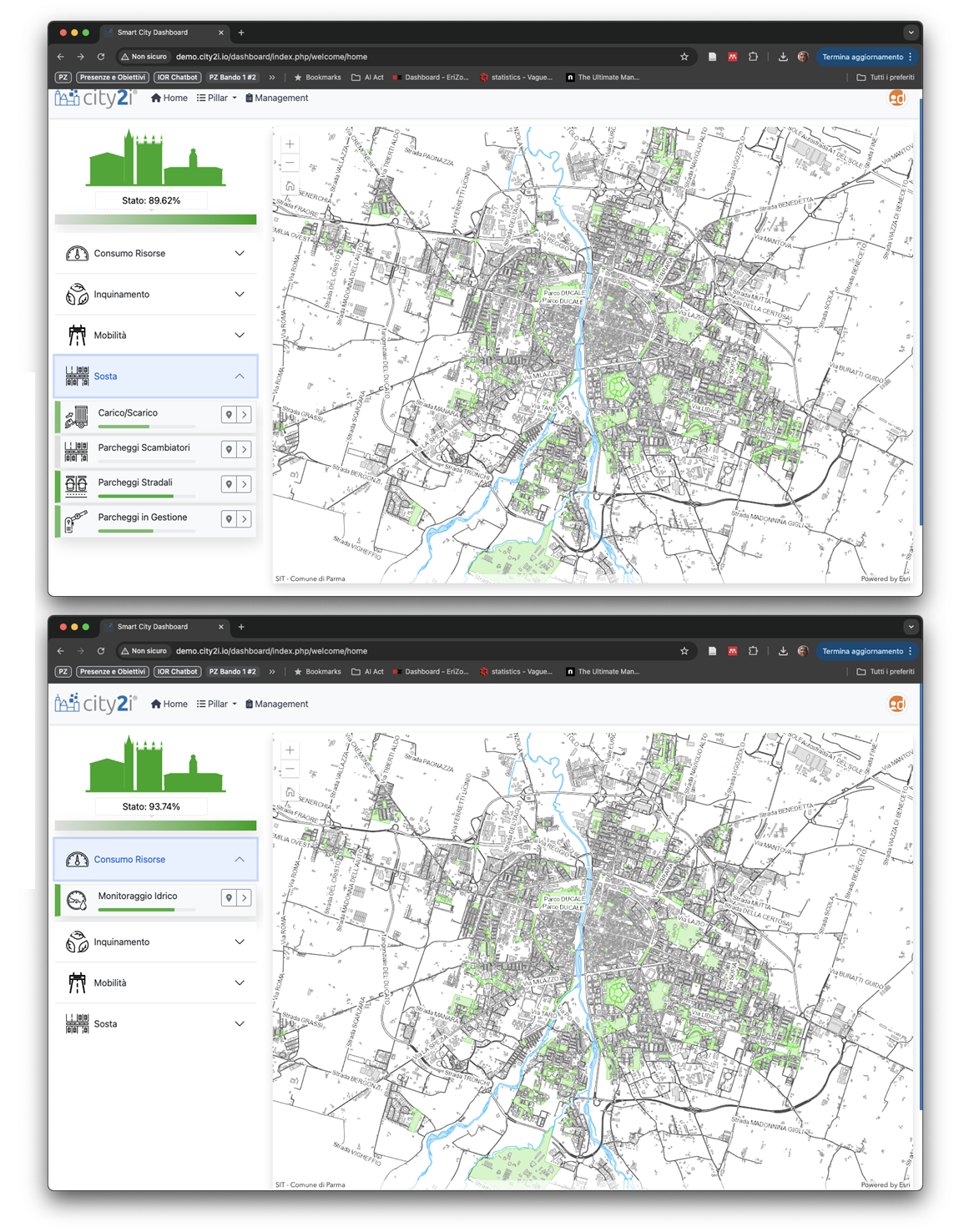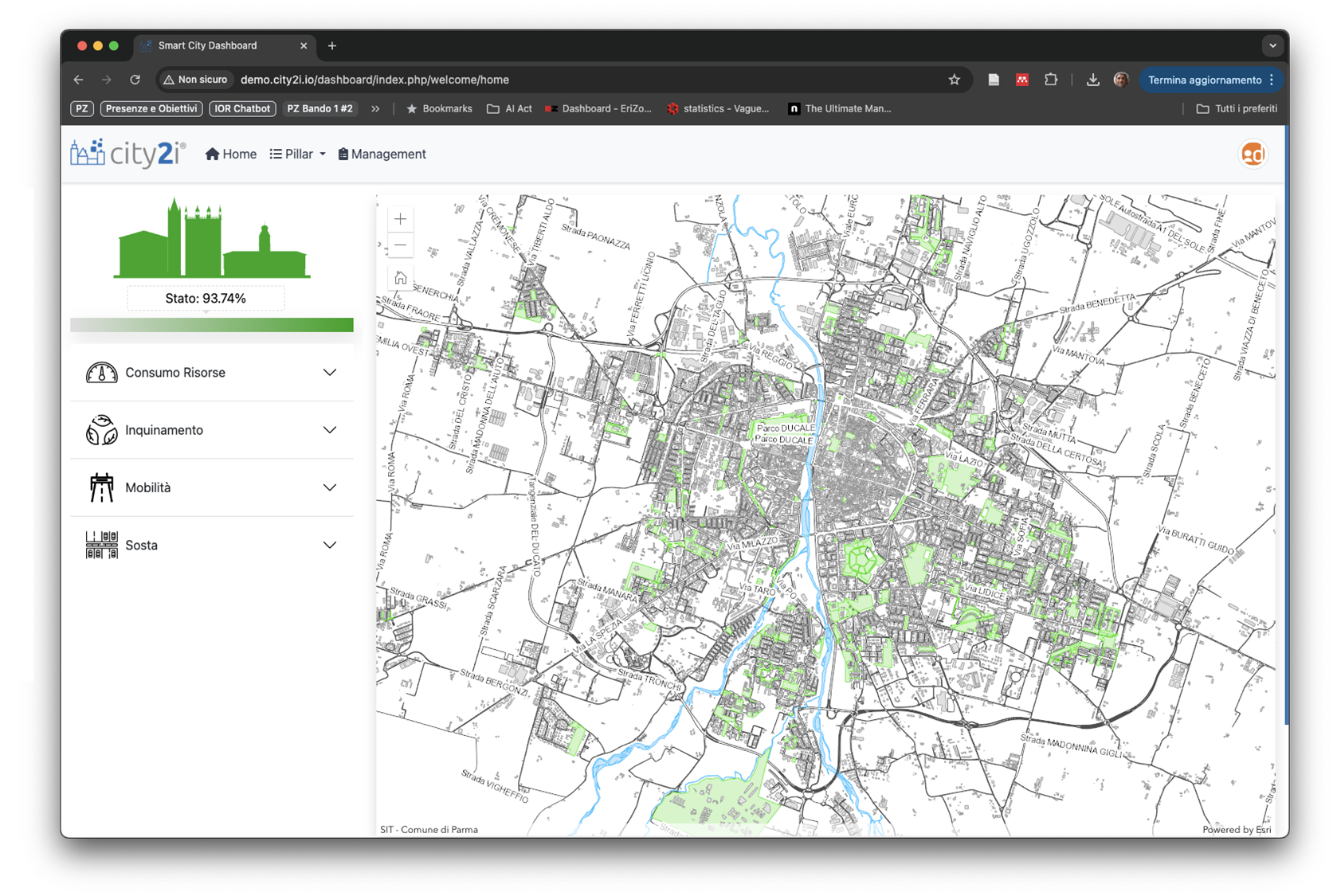General details
EDIHs involved
Challenges
The Comune di Parma is the local government authority for the city of Parma, Italy. It oversees municipal functions and services, including urban planning, public transportation, and social services. The Comune is dedicated to enhancing the quality of life for residents through effective governance, community engagement, and the promotion of local culture and events. As a key administrative body, it works to ensure the efficient management of city resources and the implementation of public policies.
The Comune di Parma faced the challenge of creating a standardised approach to support Data-Driven Governance. The primary issue was the lack of a cohesive and shared perspective among various PSO sectors on how to contribute uniformly to establishing a Data-Driven Governance framework.
To address this, the baseline of the approach is a software solution that offer both data supervision and detailed drilling capabilities, aiming to unify the sectors under a common view. This shared view was the starting point for the development of an increasingly complex idea targeted at collating different data sources to provide insight on different PSO goals. Ultimately, these goals may coincide with UN-SDGs: within UN-SDGs approach any information source may provide insight to multiple SDGs. The flexibility of the solution provides the tools to manage this diffuse contribution approach of single policies to SDG, allowing to collect within different pools data stemming for the gauging of one policy.
Solutions
The practice is based on a specifically designed software solution for sophisticated data representation, known as the DDG-Pillars. This solution transcends traditional dashboard concepts by facilitating a truly holistic approach to organisational management. It fosters direct and meaningful interaction among all stakeholders involved in governance—such as Stakeholders, Policy-Makers, City Managers, and Technical Personnel—ensuring comprehensive collaboration in establishing, developing, managing, and maintaining governance policies.
Unlike approaches constrained by the Capability Maturity Model Integration (CMMI) of PSOs, this practice supports both top-down and bottom-up methods for developing a Data-Driven Governance (DDG) framework. Each party can engage with the data based on their specific knowledge level, while still having the flexibility to explore other levels as needed. This adaptability ensures that all involved can review and utilize data insights in a manner best suited to their role, promoting an inclusive and effective governance process.
Results and Benefits
Assuming the most common approach in addressing any DDG policy, the bottom-up one, users are enabled to collect data from their data sources, including sensors, develop metadata, and maintain a current state of the sensor (in case available).

Then each data-source is pooled with other data-sources, namely within a Pillar. In the simplest case, Pillars are collection of homogeneous data-sources (e.g., water-consumption meters). The great advance in the DDG-Pillars practice is in neutrality with respect to the pooling. This concept will be further discussed. Until a Pillar is created, it is the technical of the PSO that is accountable of its instantiation. Likewise, when a Pillar starts collecting data, the accountability for the management of the data pool (not of the single data-sources) is assigned to the management party. As an example, the Budget Manager of the PSO becomes accountable for the supervision of the water consumption, as the overall consumption is measured by the whole collection of the water-consumption meter sensors. This approach is logically linked with the expected outcome of a managed service that is supported by data-sources: the pool constituting the *Pillar* is identified because of one or several management requirements, and therefore the accountability for the state of the *Pillar* is assigned to the relevant Manager.
 The pooling of different *Pillars* constitutes a Governance view of the state of the PSO. Continuing the former *nano*-example, the occupancy of school rooms and the water consumption enable a governance action, supported by the Education and Budget managers. The confrontantion with the Stakeholders at any level may be supported by the common view given by the solution.
The pooling of different *Pillars* constitutes a Governance view of the state of the PSO. Continuing the former *nano*-example, the occupancy of school rooms and the water consumption enable a governance action, supported by the Education and Budget managers. The confrontantion with the Stakeholders at any level may be supported by the common view given by the solution.
The first benefit stemming from the solution is the opportunity to share within the same administration of a single tool to display the measures. Measures need not to be similar in physical nature, nor the measure need to refer to similar geographical or temporal domain. Each measure can be collected at the required frequency ad consequently be mapped to the relevant geographical area at the specified time interval to which the measure refers to. Similar to a management tool, the solution provides the relevant information for the maintenance of the sensors, as well as alarms in case the data are either not available or prone to errors. Similar to a Data Dashboard, the solution, provides the current measurements and the time shape of the measures to provide a managerial view of the collated sensors in the pool. Similar to a BIA tool, the solution provide a comprensive view of all the pools and enables the tracking of policies at governance Level.
The second benefit resides in the opportunity to merge measures stemming from different sources with different domains within a common pool. As an example, the case of number of incidents in tiled areas can be approached merging in the same pool different sources, such as the the resident population (areal, low frequency changing measure), the sites of the incidents, the brightness measures of the streets by means of light sensors, the presence or the absence of aggregation sites, the speed of the vehicles at the major intersection point, etc. The pool can provide a supervised overall view as well permit a drill down at specific time and places to improve the knowledge of the phenomenon.
An additional benefit derives from the opportunity of a shared approach to the analysis of data, when possibly different solution adopted from different municipalities adopt the same approach to visualize data. The solution solution is not necessarily the only one that enables the comparison of phenomena by means of collating data in similar pools, but the solution principle of the DG-Pillars supports the simplification of the copmarison, and the highlight of possible sources of distinction among different cases.
Perceived social/economic impact
By improving the willingness of undertake Data Driven choices the benefit are spread in the all three dimension of economy, effectiveness and efficiency.
There is non need to repeat the reason of the importance of data management. Here we wish to highlight the opportunity to establish some benchmarks that can provide a clear understanding of the ways to improve a specific situation. Going back at the UN-SDG 6, we can easily recognize that a proper defined DG-Pillar enables a comparison with similar experiences. It also avoid to confuse technical reasons for the attainment of the targets against governance choices that did not enabled the expected change.
This result is accomplished because similar pools are copmared and can be compared throughout the development.
Measurable data
The KPIs for the solution are still under development.
DMA score and results - Stage 0
The overall Digital maturity level obtained by Comune di Parma is of 75%. The detailed level for each of the dimensions is:
-
Digital Business Strategy 93%
-
Digital Readiness 78%
-
Human-Centric Digitalisation 93%
-
Data Management and Security 53%
-
Interoperability 56%
-
Green Digitalisation 79%
Lessons learned
 The solution has shown the feasibility of a software solutions that goes beyond the Data Dashboard approach. Therefore it shows the possibility to avoid to mess the governance choices with the of the technical choices.
The solution has shown the feasibility of a software solutions that goes beyond the Data Dashboard approach. Therefore it shows the possibility to avoid to mess the governance choices with the of the technical choices.
Taking the Availability of Water UN-SDG 6 as a reference case, complete, satisfactiory, partial on unsatisfactory attainment of the goal can constitute the target of a DG-Pillar within which a number of measure are collected: as a simple, IoT driven example, indicators 6.3 and 6.4 (water quality and water-use efficiency) can be jointly viewed in the same pillar and equally weighted to measure the attainment of the overall 6 UN-SDG. Governance policies need not to be involved neither in the choice of the sensors, nor in the choice of the thresholds: these topics are more effectively discussed at managerial level for what concerns the measure sites, and at technical level for what concers the sensor characteristics.
The solution shows that a shift in the perception of the use of the data is possible and that shift can have a beneficial impact in the Governance attitude in taking Data Driven choices.


